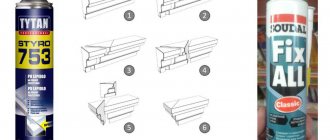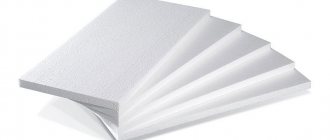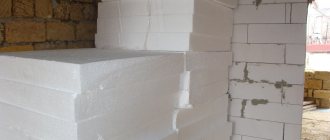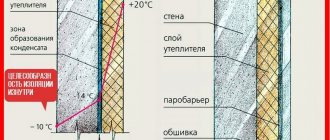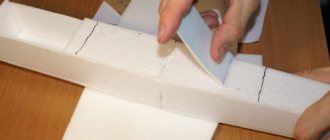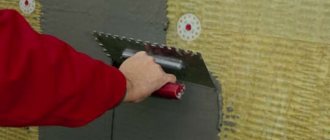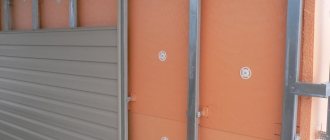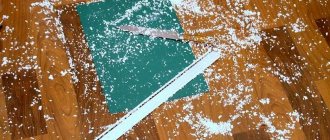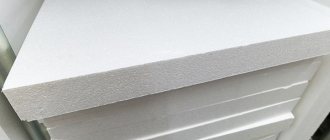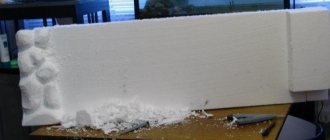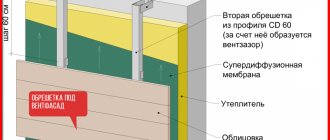Expanded polystyrene is a modern insulation material created using heat treatment with the addition of polymer granules to a foaming component in an extruder. “Extrusion” is a technological process in which a component is pressed into a foam mass at high temperature to give it the desired properties.
As a result of this process, the new material compares favorably with conventional foam in a number of parameters:
- high strength, water resistance, low vapor permeability, durability, environmental friendliness, fire safety.
High thermal insulation qualities and durability have made expanded polystyrene almost indispensable for insulating buildings. More than 75% of the territory of our country is in harsh climatic conditions.
There are several ways to use polystyrene.
Laying foam plastic inside hollow walls. This method is applicable directly during construction. The method of insulating walls with polystyrene from the outside has become widely used. This is the most commonly used method, which is used both in the construction and reconstruction of various objects, and insulation of already constructed buildings.
The use of expanded polystyrene in the construction and reconstruction of buildings
External wall insulation with polystyrene foam has received the most widespread use in the use of this material. The thickness of the sheets in this case is from 50 mm to 100 mm.
Before starting this work, wall preparation is important. The foam is attached to the walls using special glue and plastic mushroom-shaped dowels. According to the work technology, reinforcement with dowels is carried out only three days after gluing.
For corners use a special corner profile.
All this prevents the material from slipping while the glue dries during work. After all, the amount of slipping of even a light sheet can reach 10 cm. After gluing the foam sheets, a reinforcing mesh is used to create a more rigid layer under the plaster. This will make it easier in the future to finish the building’s exterior, plastering and painting. External thermal insulation work can only be carried out on days without rain.
Application of mastic under the mesh, leveling mastic, or primer should be done only after the previous layer has dried. The air temperature must be at least 5 C°. High environmental characteristics and fire safety made it possible to use this material for insulation from the inside of the house. Such work is carried out if external installation is impossible or inconvenient.
Instructions for insulating walls with foam plastic from the outside
Stage 1 – selection of material
Insulation of an external wall with polystyrene foam is a multi-layer structure. This cake gives the insulation additional properties, in the form of strength and aesthetics. It also allows you to protect the material from the destructive effects of the external environment.
For external insulation, it is better to choose polystyrene foam of the PSB-S-25 brand.
Nuance: This choice is determined by two factors - strength and thermal insulation properties. Of course, a material with a density of 15 will retain heat better. Because it has more air. But PSB-S-15 foam plastic is more fragile.
Disadvantages of PSB-S-15 foam
(when used in external insulation)
- crumbles a lot during operation;
- difficult to trim evenly;
- it is almost impossible to grate the sheet;
- plaster does not adhere well;
- The plastered surface of the wall is easy to push through.
The thickness of the foam sheet depends on:
- desired effect;
- region (the temperature in the cold month, the strength and direction of the wind are taken into account);
- the material from which the wall is made.
A nuance: insulating a brick wall from the outside with polystyrene foam puts forward even more demands on the accuracy of calculating the thickness of the sheet. Because a thin layer will result in the dew point not moving towards the foam, but remaining in the wall. Then, the moisture that will collect in the brick will increase the rate of its destruction. And if the foam layer is too thin, then in winter the moisture will turn into ice. As a result, bubbles will form on the wall, and the sheet will simply be torn out.
Advice: if the required sheet thickness is 100 mm, it is better to buy two 50 mm each. and mount them overlapping. This will eliminate cold bridges at the joints of the sheets.
Material for external wall insulation with foam plastic
- sheets (plates) of foam plastic;
- starting profile;
- construction glue;
- dowels with a wide head (mushrooms, umbrellas).
Tip: If you use foam plastic with a thickness of 50 mm, then for a concrete base the length of the dowel should be at least 90 mm, for a brick base - at least 120 mm. The dowel must enter the wall at least 50 mm.
- perforated corner with reinforcing mesh;
- polymer reinforcement mesh;
- profile for slopes;
- plaster;
- paint for facade work.
Stage 2 – surface preparation
The wall is inspected for defects (cracks, peeling, biological formations - moss, fungus). The protruding parts will later be covered with foam plastic, and those that are poorly fixed will be knocked down. If the old plaster comes off (peeled) from the wall, it also needs to be removed.
Sometimes there is moss on the walls - it needs to be scraped off. Paint, if any, is also removed. And any other layer with zero vapor permeability.
If there are deep cracks in the wall, they need to be repaired. To do this they need to be expanded. Prime the resulting V-shaped channel. Then seal it up. Sand-cement mortar, foam glue or construction foam are suitable for sealing.
Cracks in the walls
Technology for sealing cracks in walls
The prepared wall surface is primed.
Priming the walls For priming, use a universal deep penetration priming solution. This will protect the wall from fungus and other biological activity, and will also increase surface adhesion.
Tip: The suitability of the surface can be checked as follows. A block of foam plastic measuring 10x10x10 mm is glued to the wall with an adhesive solution. Three days later it is torn off. If the block comes off completely, it means the wall is unusable and requires further cleaning. If the block breaks but holds, you can start working.
Is it possible to insulate the walls of a wooden house with polystyrene foam?
It is better not to insulate wooden walls from the outside with polystyrene foam. This is due to the fact that wood has natural moisture. In order for it to be able to release moisture to the external environment, insulation with a porous structure is needed. Mineral wool would be ideal in this case.
From a practical point of view, insulating wooden walls with foam plastic is possible. Provided there are no serious cracks in the tree. Otherwise, before starting work, you need to seal them with natural insulation - moss, felt or a special acrylic sealant, which allows you to seal even the most minor defects and crown joints. In addition, installation of polystyrene foam is carried out only using the frame method.
Insulating wooden walls from the outside with polystyrene foam - pros and cons
Stage 3 – marking
In this case, marking does not mean that you need to apply a drawing to the entire wall. Such a grid will only confuse, because... the foam sheet has a tolerance of 10 mm. by 1 m.p.
But it is simply necessary to measure the horizontal and vertical. Because it is not always possible to match the angle, because... the wall may have slight deviations.
Stage 4 – installation of foam plastic on the wall and facade
Advice for beginners - start working on the wall that is least noticeable, this will be your training ground.
The installation of foam plastic on the wall begins with the installation of a starting profile. Its width is equal to the thickness of the foam sheet. Sometimes the UW-50 or 100 profile is used for these purposes. These are the most popular sheet sizes for insulation.
Note: It is better to use a special starting (base) profile, because it contains perforation, which allows the fastener to securely fix the profile, and at the same time allows its movement due to thermal expansion.
The starting profile is mounted according to the previously applied markings. Its use allows you to lay the first row of sheets absolutely evenly. In addition, there is a popular opinion that a metal starting profile will protect the sheet from rodents.
To level out the thermal expansion of the metal, a gap of about 5 mm must be left between adjacent profiles.
Fastening the profile for foam insulation
The arrangement of the corner is shown in the photo
Installing a corner for foam insulation
Methods for attaching foam
The foam installation technology has several modifications. To fix the sheet on the wall, you can choose one of three options:
- Apply glue to the edge of the sheet and make several sculpts over the area of the sheet. This method is suitable for uneven walls;
Method of attaching polystyrene foam to an uneven wall
- Apply glue with a notched trowel over the entire sheet. Option for a relatively flat wall;
Method of attaching polystyrene foam to a flat wall
- apply special glue from a bottle. This glue is similar to construction foam. At the same time, it is much easier to work with than with an adhesive solution. Plus, it doesn't require kneading and secures the sheet firmly to the wall.
Fastening polystyrene foam with glue from a can
Next, the foam plate is attached from the bottom corner according to the applied markings.
The second row of sheets is laid offset as shown below. This scheme makes installation more reliable and reduces the likelihood of cracks.
Offset foam fastening scheme
So all the rows are laid out in order down to the last one.
Tip: In order for the glue to set completely, the wall covered with foam plastic must stand for 3-4 days. If you do foam insulation with your own hands, then by the end of the work the first section usually has time to stand for the required time.
Particular attention should be paid to the finishing of slopes, because this is also a source of heat loss. The finishing process in the photo.
Installation of slopes when insulating with foam plastic
The window sill will have to be replaced after installing the foam.
To ensure that there is no heat loss where the insulation joins the frame of a metal-plastic window or door, you need to install a special window profile. Due to the fact that the profile has a self-adhesive strip, it is easily installed on the window frame. Installation process in the photo.
Installing a window profile with foam insulation
Installation of the profile guarantees the absence of deformation and a finished appearance.
You should not assume that after insulation with polystyrene foam the house will turn into the same type of box. By varying the thickness of the sheets or laying and securely fixing them in several layers, you can create any wall configuration.
Stage 5 – additional fastening of foam plastic to the wall
Umbrella dowels (fungi) for fastening foam. Reliable fixation can be provided by special plastic umbrella dowels (fungi) for fastening foam, which do not “fall through” into the sheet, but securely fix it.
There are two ways to mount umbrellas, as shown in the figure.
The first option is suitable for smooth joints. If there are significant gaps between the sheets, then you need to use the second option.
Note: The first option will save dowels, but it will take time to adjust the sheets to size.
Fixed umbrella dowel When installing the dowel, make sure that it is slightly recessed into the sheet.
It is worth noting that in the classic version the umbrella is mounted as shown in the photo. However, since such installation takes a lot of time, and the plastic dowel does not create cold bridges, even experienced builders neglect this rule.
Method of fastening foam plastic with “recessing” the head of the dowel-umbrella
The gaps formed at the junction of two sheets are sealed with foam. If the gap is more than 20 mm wide, the gap is sealed with a piece of polystyrene foam. For greater reliability, the back side of the trim is coated with glue or foam.
Sealing the necks at the foam joints
After sealing all the cracks, begin trimming the protruding parts of the sheet that meet at the corners.
Next, the surface of the walls is sanded with a foam float.
Foam sanding grater
Tip: If a wall finished with foam plastic has stood for more than 2 weeks without finishing, it will have to be sanded completely, because... ultraviolet radiation has already damaged the surface layer of insulation.
Stage 6 – finishing corners and slopes with foam plastic
Perforated corner with reinforcing mesh Corners of the house or slopes need additional protection from impacts. In addition, it is difficult to ensure the required mesh overlap here. Yes, and cutting the foam perfectly can be difficult. Therefore, a special perforated corner with reinforcing mesh is provided for them.
It is attached with glue and pressed tightly using a special corner spatula onto the outer or inner corner of the house, or slope.
The process of installing polystyrene foam at the corners is shown in the photo. Inside the slope, as already mentioned, a special corner is used.
The process of installing foam plastic on corners and slopes
At this stage, the house is ready for further finishing.
Stage 7 – façade plaster on polystyrene foam
External wall insulation with foam plastic helps protect the house from heat loss. But what will take care of protecting the insulation itself? Finishing (facade, decorative) plaster, siding, lining or any other finishing material. In our example, this is plaster.
Its basis is a polymer reinforced mesh for foam plastic with cells 3x3, 4x4, 5x5. The mesh density is in the range of 140-160 g/m2. The purpose of the reinforcing mesh is to ensure the integrity of the wall surface and prevent the appearance of cracks.
Advice: do not be tempted by the low cost of the mesh - in this case, saving is inappropriate. High-quality mesh is coated with a special solution that protects it from the influence of alkalis and acids contained in adhesive solutions. Poor quality mesh will “dissolve” in the glue.
How to attach the mesh to the foam?
Fastening the mesh to polystyrene foam - 1 The mesh is fixed with glue. The same one on which the foam was attached. There is a special marking on the mesh. The red stripe shows how much fabric should be overlapped. This is approximately 100 mm.
If there are no markings, try to maintain an even overlap along the entire length of the strip.
Attaching the mesh to polystyrene foam-2. Procedure for attaching the mesh: cut a strip of mesh of the required length, plus 250-200 mm. Glue is applied to the top of the wall. The area of the adhesive strip is approximately 100x10 mm. The mesh is placed on it and pressed. Roughly speaking, the mesh should sink into the glue.
Trimming excess mesh Tip: make sure that the mesh does not bunch up. Level it with a spatula. But don't overdo it, otherwise you'll pull the entire strip down. At the bottom, the excess mesh is trimmed off.
In order for the putty to cover the mesh over the entire surface of the wall, it must be applied in two layers. One thick layer will be covered with microcracks. This will not cause harm, but the defect will be visually noticeable. Please note that the previous layer must dry completely.
Advice: do not work with putty in windy weather. Otherwise, the layer will dry out quickly, which will also lead to the appearance of microcracks.
Stage 8 – priming and finishing
As the name of the stage suggests, the main work here is related to priming the wall surface. And then they begin applying finishing putty and/or painting.
More visual information on how to insulate an external wall with polystyrene foam is contained in the video instructions
Ignoring the rules for installing foam plastic when performing external wall insulation can lead to unpleasant consequences.
Consequences of poor-quality foam installation
Features of the work on insulation with polystyrene foam from inside the house
Insulating walls with foam plastic from the inside of a house has its advantages and disadvantages. The work on fastening to the wall is not affected by external weather factors; the area of the insulated surface is relatively small, which eliminates unwanted sliding of the sheets. As a disadvantage, one can note the reduction in the internal volume of the building.
The additional thickness of the insulating structure further reduces the area of the rooms. For internal installation of insulation, the thickness of the foam sheets can be no more than 40 mm, and fastening can only be done with glue. The use of profiles for laying foam plastic and additional fastening with dowels can be abandoned.
It is quite possible to do this work yourself. How to attach polystyrene foam to the wall. There are two ways to attach foam to the wall - using glue and mechanical fastening with dowels “fungi”. Mechanical fastening is usually used as additional fixation of glued foam. To fasten using this method, it is necessary to profile the wall with thin wooden blocks or special profiles.
They are aligned in a plane; this determines how evenly the polystyrene sheets can be strengthened. Holes are drilled in the profile according to the diameter of the dowels used, usually 8 mm. Using dowels and these holes, the material is attached to the bars. We will not consider fastening with drilling directly into the wall as extremely inconvenient.
Attaching to wood
Polystyrene foam is attached to wood in different ways.
- It has long been known that wood must “breathe”, otherwise rot will appear. Only thanks to the air flow, the tree retains its characteristics for many years.
To protect the wooden wall from rotting, foam plastic is laid with a ventilation gap. For insulation, a lathing is made from wooden blocks. The slabs are inserted between the bars. A vapor barrier layer made of foil film protects the insulation from condensation.
- Special metal nails can securely hold slabs on wooden surfaces. Unfortunately, cold bridges appear at the fastening points, so high-quality putty is required. When plastic nails , the thermal insulation of the slabs is improved.
- Fastening with adhesives is simple and reliable. The main thing is to choose the right glue that is resistant to changes in ambient humidity and temperature. A solution containing cement and glue has worked well.
The optimal way to attach insulation to the wall from inside the house
The most convenient and less expensive method of fastening is fastening with glue. The possibility of abandoning the mechanical method was discussed above - small areas and the absence of unfavorable climatic factors.
This work can be carried out in several steps over two days:
Preparing the wall surface. The quality of the entire work depends on the basis on which the insulating material rests. The quality of surface preparation determines how firmly the foam will stick to the wall and how much glue will be needed to attach the sheets.
The wall must be carefully leveled and primed. The surface of the foam, on the contrary, should be rough for better adhesion to the glue. Selection of the optimal glue for attaching sheets of foam to the wall. Dry glue mixture or polyurethane foam glue?
It all depends on the skills at work. It takes much more time to properly prepare glue from a dry mixture, and the quality and consistency of the glue must be constantly monitored. Laying insulation sheets using polyurethane foam is faster and the adhesion is better.
But the complexity of preparing glue and the long duration of the work itself are compensated by the absence of errors with little experience in this field. Foam dries faster and requires experience and skill from the master. An important factor is that polyurethane glue in cylinders is much more expensive, and the quality of adhesion for glue made from a dry mixture is not much lower.
The glue is applied to the foam sheet using a notched trowel evenly over the entire surface in a layer of about 1 cm.
The sheets are glued to the wall starting from the bottom to avoid slipping while the glue dries. It is advisable to arrange the foam sheets in a checkerboard pattern, as when laying bricks. This way the whole structure will be more stable.
Gaps should be minimal. If foam is used, glue is applied around the perimeter of the sheet at a short distance from the edge and in the center. After gluing, the gaps between the sheets are filled with the same glue and puttied.
After the glue has dried, mastic is applied to the insulation and a reinforcing mesh is laid on it. The mesh should be recessed in a layer of mastic, this will give greater stability to the entire structure and will facilitate further work on the wall. The use of mastic and reinforcing mesh further strengthens the entire structure on the wall.
Plastering does not relate to the process of attaching polystyrene foam to the wall, but this is the logical completeness of the entire process. For all the work you will need: The polystyrene foam sheets themselves of the required area. A dry adhesive mixture at the rate of 3 kg per 1 m2 of wall area. 1 bag contains 25 kg of dry mixture. If you decide to use foam, 1 bottle replaces one bag of dry glue. Reinforcing mesh, mastic (consumption of the finished mixture is 2-3 kg per 1 m2). Spatula, trowel, level and a classic set of home craftsman tools (hammer, screwdriver, knife, ruler , compass, masking tape). An electric drill, if you are planning to fasten with dowels. The use of polystyrene foam for home insulation has its supporters and opponents.
Modern developments of this material make it possible to use it for residential premises without fear of adverse effects on health. Lightness, environmental friendliness and fire safety in addition to ease of installation make this material very competitive in construction and repair. Ivan Publitorov Insulating a house is an important issue for its owner. One of the most popular materials used for insulation and additional sound insulation is polystyrene foam. It is reliable and effective, does not put additional load on the walls. If the decision is made to use it, then the home owner is faced with the question of how to attach the foam to the wall, what kind of fastening to use in order to get a reliable, strong structure.
Foam plastic and penoplex are the most popular materials for insulation and sound insulation of house walls, because... they are practical and inexpensive.
How and with what to glue to concrete, wood and brick surfaces
If you need to mount polystyrene foam to a concrete base when carrying out external thermal insulation work, then it is better to use dry compositions in powder form. This is explained by the fact that they contain a cement component, polymers and sand, which provide reliable adhesion.
The best means are:
The “T-Avangard-K” composition is suitable for attaching foam plastic boards not only to concrete, but also to brick bases, gypsum and cement plaster. The dry mixture is available in 25 kg bags. One package is diluted with 5-6 liters of water. The powder is good for 6 months from the date of issue. Summer and winter versions are available. The first is recommended for use at temperatures from +5 to +35° C, the second - from –10 to +5° C. The cost of one bag is, on average, 275 rubles.
Related article: How to attach drywall to a wall without profiles
Polyurethane foam Ceresit CT-8
Ceresit CT 83 (“Ceresit CT 83”) is a high-quality quick-hardening composition that is perfect for any mineral base. Available in 25 kg bags, the finished mixture should be used within two hours. The price per bag varies from 413 to 539 rubles.
The ready-made adhesive mixture (adhesive foam) Ceresit ST 84 Express should be used at temperatures from –10 to +40° C and in conditions of high humidity. It is perfect for concrete, brick surfaces, as well as cellular blocks and OSB boards. Ceresit CT 84 Express adhesive foam consists of butane, propane and polyurethane. One cylinder with a capacity of 750 ml costs 600 rubles.
Rolled foam plastic is most often used for finishing and thermal insulation indoors. For it, it is better to use gypsum-based powder mixtures.
Gypsum Perlfix is produced by Knauf. Packaged in 30 kg bags. The glue will do an excellent job of gluing foam plastic to substrates made of foam concrete, plaster, and ceramic brick. It is not necessary to level the surface before using the composition. To increase the adhesive properties, foam blocks are pre-treated with concrete contact. It is not recommended to work with glue if the room temperature is below +5° C. One package of Perlfix weighing 30 kg costs, on average, 280 rubles.
Foam plastic is a high-quality and at the same time inexpensive building material, which is successfully and often used as insulation in almost any room. For gluing it, dry mixtures, ready-made adhesive compositions in the form of aerosols and “liquid nails” are used. When deciding which glue is best for gluing foam plastic, you must keep in mind that the composition in powder form will be cheaper, but the finished mixture is much more convenient to use. When carrying out work outside the building, on the facade, be sure to use dowels for additional fastening.
Preparatory work
Before attaching the foam, you need to prepare the surface.
There should be nothing on the wall that could interfere with the work. All structures must be removed. Clean the surface from dust.
If there are cracks, chips, unevenness or other damage on the wall, then they must be eliminated before attaching the insulation. Irregularities on the wall of more than 1 cm can cause insulation failure. If the walls are damp, they need to be dried.
The next important step in preparation is treating surfaces with special compounds that will prevent the formation of mold and mildew. The next stage of work can be started only after they have completely dried.
Scheme of insulating walls from the outside with polystyrene foam.
After the preparation is completed, you can begin drawing up a diagram of the location of the foam sheets on the wall.
Such a scheme will help to minimize losses from cutting sheets. On the wall they should be arranged in a checkerboard pattern. If the foam needs to be cut, then it is better to use a mounting knife.
The foam can be attached in several ways: with glue or mechanical fasteners.
To fasten foam plastic to the wall, use special dowels, which are also called umbrellas or mushrooms. You can use any of these methods, but, as practice shows, it is most rational to simultaneously glue and nail the foam. During facade work, this technology is most justified, especially if heavy facing materials will be used later.
It is better to fasten the insulation only with glue during interior work; this will be quite enough. Dowels do not need to be used as fastenings for foam plastic, since heavy facing materials are not used during interior work
Return to contents
The easiest way to attach foam to the wall is to use glue. Work begins from the bottom with the installation of a starting bar.
The plank will become a reliable support for the bottom row and will not allow it to move. This method will allow you to do the job correctly and with better quality. If you do not use the limiting strip, then until the adhesive mixture dries, the foam can drop up to 10 cm.
Scheme of external insulation from foam blocks.
The thickness of the starting strip should be equal to the thickness of the insulation sheet. In addition to the strip, to attach the insulation, you will need:
- Tile adhesive. Construction mixer. Electric drill. Large and small spatulas. Container for glue.
When preparing the adhesive mixture, you must strictly adhere to the instructions. Using a construction mixer attached to an electric drill, prepare the solution, strictly observing the proportions of water and dry mixture.
Return to contents
Two spatulas are needed to make it more convenient to work. The small one is used as a spatula to spread the mixture onto the large one.
On a perfectly flat wall, you can work with a spatula-comb with special teeth. If the surface has differences of more than 1 cm, then the mixture is applied to it with a spatula in separate “islands”. Due to this, all differences are leveled out as much as possible, that is, a larger amount of glue is placed on the unevenness, and less on the protrusions.
Graph of thermal insulation properties of insulation materials.
The adhesive mixture can also be placed on foam plastic. Manufacturers recommend applying it evenly over the entire surface.
But here you may encounter the following problem: if the wall is uneven, then half of the sheet may not stick. In addition, the sheet will become 3-5 kg heavier and will be inconvenient to work with: hold, fasten, level. Therefore, for convenience and reliability, it is better to apply glue to the wall.
The adhesive mixture is applied in “islands” along the perimeter of the foam sheet. "Islands" can be of various sizes. The main task is to level the insulated surface as much as possible if there are depressions on it.
All existing protrusions should be knocked down, if possible. Alternatively, you can scrape off the insulation sheet a little in the place where the protrusion hits. In addition, the glue must be applied to the wall along the perimeter of the sheet in a broken thick line.
For this it is better to use a small spatula. This technique will allow some of the glue to get under the adjacent sheets. Thanks to this, the joints will be more durable.
Attach the sheet to the prepared surface and press lightly. To avoid making dents, fasten carefully. The sheets are stacked in a checkerboard pattern.
Return to contents
One of the types of fastenings for foam plastic are special dowels - mushrooms, which consist of a plastic circle (hat and plastic sleeve) and a “leg”. A plastic or metal nail is driven into the sleeve. It is better to fasten with plastic nails.
For work, in addition to the dowels themselves, you will need:
- Perforator.Drill.Hammer.
The depth of the hole for fastening should be 20 mm greater than the length of the fungus. To decide how long to prepare the fungi, you need to add 1 cm to the thickness of the insulation as the thickness of the other layers on the wall and add another 3-4 cm to the recess.
For example, with a foam thickness of 50 mm, you will need mushrooms with a length of 50 + 10 + 40 = 100 mm. In this case, the depth of the hole will be 100+20=120 mm. You need to prepare a drill for the hammer drill of the same length.
Fasten the sheet with at least 5-6 dowels, placing one in the center, the rest at the joints of the sheets.
Thanks to this, the joints are better pressed. If necessary, you can attach more material. Dowels are considered the best and most reliable among foam fasteners.
First prepare the holes for the fasteners. Then insert the fungi into them, without nails for now.
Hammer it with a hammer so that the cap is level with the surface of the insulation. When all the fungi are installed, you can start driving nails inside. A correctly hammered mushroom is immersed in the insulation by 1-2 mm.
It is very important to take into account that the insulation can be nailed no earlier than 3 days after gluing is completed. During this time, the adhesive mixture will dry and the foam will not move away from the wall.
To insulate buildings during modern renovations, materials derived from polystyrene foam are often used: polystyrene foam, penoplex. Their composition is more than 90% air. This determines their high thermal insulation properties.
Before attaching polystyrene foam to the wall outside or inside the premises, you should prepare the working surfaces and decide on the installation method. Not only the service life of this material, but also the durability of the decorative finish will depend on the quality of fastening of the sheets.
The procedure for attaching foam to the wall
To insulate buildings during modern renovations, materials derived from polystyrene foam are often used: polystyrene foam, penoplex. Their composition is more than 90% air. This determines their high thermal insulation properties.
Before attaching polystyrene foam to the wall outside or inside the premises, you should prepare the working surfaces and decide on the installation method. Not only the service life of this material, but also the durability of the decorative finish will depend on the quality of fastening of the sheets.
Preparatory activities
You can insulate a house with polystyrene foam in 2 ways: with glue or with special dowels
Insulation allows you to save on heating the room. You can attach the foam to the wall after preliminary preparation of the surface.
The process consists of performing a series of actions to level and strengthen the base. It all boils down to this:
- unnecessary structural elements are dismantled from the working surface; falling sections of the finishing coating are removed to a solid base, after which they are plastered again; the walls are checked for unevenness with a level; if necessary, the entire surface is leveled and puttied; after drying, the dust formed on the installation surface should be washed off with water (you can wipe with a damp cloth); when the moisture has evaporated, apply sequentially: a primer layer, a solution against mold and fungi (with a brush or spray); before attaching polystyrene foam, you should take measurements of the wall (to order consumables in the required quantity, in a convenient format).
Preparatory operations also include the selection of tools. To carry out the work, depending on the chosen fastening method, you will need the following set:
- spatulas of different sizes; construction knife, stapler; level, tape measure, pencil; hammer drill (impact drill); mixer or attachment for stirring the adhesive solution; sandpaper (grater); hammer; containers for glue, primer, plaster mixtures.
It is customary to pay great attention to preliminary preparation. Leveled walls without defects speed up further installation work, avoiding possible troubles (for example, panels falling off along with the plaster). It is recommended to use foam plastic 3 cm thick inside the rooms, and at least 5 cm thick outside.
How to attach foam plastic with plaster to a wall?
Let us consider in detail the method of attaching polystyrene foam to brick or concrete walls using plaster. It is convenient due to its simplicity and minimum required tools. Plaster can be mixed in any quantity, so the master himself determines the amount of work and the speed of its implementation. It is important to apply plaster mixtures at five points - many builders, in order to save money, limit themselves to only three points of contact, but this violates the technology.
Others, to increase strength, completely cover all edges with the mixture. However, in the second case, there is a significant overconsumption of the composition; it will be much cheaper to use dowels together with plaster. It is important to prepare the surface - if the walls are smooth and without cracks, it is enough to remove old paint, crumbling mortar or adhered dirt. Then the surface is coated with a primer - the primer provides better adhesion of the materials.
If small cracks are observed on the surface, they can be repaired with the same plaster. The plaster mixture for gluing slabs is diluted strictly according to the instructions. If you are working with this composition and slabs for the first time, you can make the glue a little thinner - this will give you a little more time, since the composition will take longer to harden.
Then, using plaster, a reinforcing mesh is attached to the wall - first, it is secured at the edges, and then completely rubbed with the compound. After the solution has hardened, you can proceed directly to gluing the slabs. The polystyrene foam is glued from the bottom up, and after 1-2 days you can start plastering the polystyrene foam on the outside. It is very important to grout the surface within four days after plastering, otherwise the composition will harden to a state that can no longer be processed.
Mounting methods
Fastening with fungi Installation on plaster mixture is not the most reliable
Polystyrene foam is installed on the prepared base in many ways. A description of the most common of them is given in the table. The classification criterion lies in the materials used for fastening.
No. Method Procedure, features 1 use of plaster mixtures; a solution of the required consistency is prepared according to the instructions on the packaging; in this case, the volume should be mixed for approximately 3 hours of work (after which the mixture begins to lose its properties); the solution is applied with a spatula along the perimeter of the sheet in a continuous layer (thickness from 10 to 30 mm), then several contact points are established on the remaining surface (on average 5-6 are enough); the fragment is applied to the wall; gluing is carried out from the bottom up (it is advisable to do the work in a checkerboard pattern); the sheets are pressed tightly against each other to minimize the size of the gaps; if the distance between the joints exceeds 2 mm, then the area is sealed with polyurethane foam; the disadvantage is weak fixation, it is advisable to use mixtures together with the following two methods: 2 fastening with fungi, holes are drilled in the wall through polystyrene foam (with a diameter of 0.8 cm, depending on the thickness of the plastic part of the fungus); the dowel is inserted and hammered in so that it fits at least flush with the surface; the use of fungi allows both attaching and dismantling fragments without consequences; There are 2 common options for the location of dowel nails: 4 pieces in the corners, 1 in the center for one sheet; inserted along the joints, securing several fragments at once 3 with the help of adhesives; the scheme of work is similar to the use of plaster mixtures; It is easier to apply the glue with a gun. Attaching polystyrene foam or polystyrene foam to a brick wall, as well as a wooden, concrete, or stone wall can be done using any of the described methods.
Extruded polystyrene foam is gaining increasing popularity as insulation. In terms of its characteristics, it is superior to ordinary polystyrene foam, but is more expensive in price. To install it, you don’t need to invent anything - just use the methods outlined.
The use of the considered installation options allows you to securely fasten polystyrene foam for a long time (if all work is carried out correctly and sequentially). To achieve a high-quality result and some savings, the foundation should be insulated with polystyrene foam, and the rest of the facade with ordinary polystyrene foam. The best effect will be from the combined use of dowels with glue.
Mushroom fastening
Without stopping at using only glue, extruded polystyrene foam is additionally attached to “fungi” - dowels with a metal or plastic nail, which, thanks to the large “cap,” reliably hold the heat insulator. One slab of standard penoplex (600x1200mm) should have at least 5 “fungi”.
Fastening a slab of extruded polystyrene foam using dowels alone is also used. This method is suitable for low walls with a small load - for example, when insulating a loggia, small basement or garage - where polystyrene foam does not have to bear the load of plaster. If, in addition, a sheathing is mounted on top of the insulation, which in turn must be securely fastened to the supporting structure (wall) through all layers, then there is no need for glue.
It could be mentioned that when installing extruded polystyrene foam to wooden walls, glue is also not used, but only fungi are enough. However, the fact is that such insulation of wooden walls is rarely practiced. Penoplex is not the best insulation for this material. However, this decision is fair when it comes to roof insulation.
Special cases at work
For gluing to a metal base, use liquid nails
Fastening polystyrene foam to a concrete, brick, or wooden wall are the most common cases. In practice, there are situations when it is necessary to fasten sheets of material to a metal surface. Then the work is done as follows:
- indoors and when high strength of the coating is not required, PVA glue is used: the intermediate material - burlap - is impregnated with it; after which it is fixed on the working surface; then slabs lubricated with the same adhesive are glued onto it; for exterior finishing it is better to use special polyurethane adhesives together with liquid nails (so that the attached slabs do not slide); you can attach the foam with polyurethane foam, applying it at 5 points on the sheet in a small amount.
The use of liquid nails separately does not provide this level of strength. Joint application will increase the speed of installation. To learn how to quickly glue polystyrene foam to walls, watch this video:
Insulation of balconies and loggias can be done without gluing sheets, spreading them out in the sheathing.
After installation, the entire surface is puttied according to the level. Sheathed either with plastic, or MDF, or gypsum board. From the outside, the foam is held, securely fixed, by the outer wall.
There are nuances when working. You can't provide for everyone. Knowledge of how to secure material and practical skills will allow you to cope with any obstacles.
To work in multi-storey buildings, professional high-altitude workers will be required
Insulating a house using polystyrene foam methods is easy to do yourself. They can be combined with each other.
The decision on how to attach depends on the operating conditions and financial capabilities. Only facade work may require the involvement of professional high-altitude workers. Well-attached sheets of foam plastic will allow you to insulate your home for decades while preserving the exterior finish.
09.10.2017
In order not to heat the air outside the house, owners try to install thermal insulation. For this, a wide variety of materials are used, ranging from mineral wool to polystyrene foam.
The most popular due to its technical characteristics and affordable price is polystyrene foam. To reduce the cost of work, the owners do all the work themselves. That’s why questions are often asked: how to attach polystyrene foam to the wall?
Fastening to metal
During insulation work, it may be necessary to attach to metal surfaces. There are several convenient ways.
- The familiar PVA glue is a good adhesive for metal and foam.
First of all, the burlap is impregnated with the adhesive composition. After that, it is glued to the metal, and insulation boards are laid on it.
- Polyurethane foam has good adhesive properties. The adhesion to metal is not very strong, but it lasts a long time.
The foam is packaged in cans, so it is applied to the stove using a special gun. An experienced specialist should work with the foam, as it dries quickly, which means that the installer’s actions must be confident.
- Polyurethane glue is well suited for joining polystyrene foam to metal . It is used in a certain technology:
- the adhesive composition is applied to the surface of the slab in strips or dots;
- after the composition has dried a little, the plate is pressed against the metal;
- In order for the slab to stick better, a wooden spacer is installed, which is removed after 20 minutes.
- liquid nails adhesive allows you to increase the speed of work. This composition instantly connects the plates and metal, but the adhesion strength is worse than with polyurethane glue. To achieve good and quick adhesion, it is recommended to use these two adhesives simultaneously.
- For small amounts of work, double-sided tape . The connection is fast, but does not withstand heavy loads. In addition, this method is more expensive than using other adhesive materials.
Mounting methods
In order for the insulation to fulfill its intended purpose, it must be properly secured to the base. Professional craftsmen use several methods to attach foam:
For the adhesive composition.
This option is suitable if the insulation will not be used as a basis for heavy finishing material. Using fasteners. A more reliable method, but also suitable for spruce on foam plastic, it is planned to install heavy decorative trim. A combination of the first and second options. The use of glue and dowels allows for the most reliable fixation.
But before you start installing polystyrene foam, you must prepare the base and all the necessary materials.
Indoor mounting
Insulating indoors is a simple process, so it can be done on your own. To ensure high-quality fastening, work with foam plastic is carried out in a certain sequence.
- The wall surface, insulation and adhesive composition are being prepared. The walls must be smooth and free of cracks and peeling. Polystyrene foam is easily cut with a hacksaw or a sharp knife. The adhesive used is a dry mixture or adhesive foam in cans.
- The finishing of windows and doors is dismantled. Subsequently, higher quality finishing elements are installed.
- The adhesive is applied along the edges of the slab, in the center and at the ends.
- Fastening the slabs to the walls is done in one of the following ways:
- in rows - the insulation is laid with a shift in rows along the entire perimeter of the room;
- pyramid - the first row is laid around the perimeter of the room, and then the corners are laid in the form of a pyramid.
- Using a spatula, remove the layer of glue squeezed out from the joints of the plates.
- The surface of the insulation is covered with a mounting mesh, and plaster is produced.
Preparatory stage
First you need to buy all the necessary materials and tools that may be useful during the installation process:
Insulation.
The required quantity is calculated in advance and must be purchased with a reserve. During transportation and even during fastening, the slabs may be damaged, so a few sheets in stock will not harm. Starting profile. Adhesive composition suitable for external work. You also need to pay attention to whether it is suitable for fastening foam plastic. Fasteners (fungus dowel) if this method was chosen for fixation. Deep penetration primer. Roller or wide paint brush (for applying primer). Sealant. Perforator.
After all the equipment and materials have been purchased, you can begin preparing the foundation. To do this you need:
- Remove old decorative trim.
If there are areas that are crumbling, then they are eliminated. All facade elements that interfere with the installation of insulation are removed. All cracks and recesses whose depth exceeds 5 mm are sealed. For polystyrene foam, it is not important that the base be perfectly level.
But if there are large depressions, then mechanical stress may cause cracks to appear both on the insulation itself and on the decorative finish. And this reduces the effectiveness of thermal insulation. Clean stains and traces of fungus or mold. The last stage of preparing the base will be the use of deep penetration soil. Particular care is taken in areas of constant exposure to moisture (basement, foundation).
Only after the soil has dried can you begin installing the foam using the chosen method. Now let's take a closer look at each method.
Ceiling mount
The main condition for such fastening is high-quality preparation of the ceiling, which includes cleaning of whitewash and dirt, as well as laying electrical wiring.
The foam is attached in one of the following ways:
- Frame method.
The sheathing or frame for the ceiling is made of wooden blocks. In order not to cut the slabs, it is recommended that the size of the sheathing cells be shaped to match the size of the sheets.
Inside the cells, foam is attached with glue or fungi. All gaps are sealed.
We seal the gaps with foam
A vapor barrier film is placed on top of the insulation, which is held on the sheathing.
At the final stage, plasterboard sheets are attached to the ceiling.
- Glue method.
This method is much cheaper than the one discussed earlier. The main thing is to choose and prepare the adhesive composition correctly.
When preparing the ceiling surface, in addition to cleaning, it is coated with a disinfecting solution and primer. When it is not possible to completely remove the whitewash, the entire ceiling is covered with an adhesive composition.
Glue is applied to the slab in broken lines. The slabs are laid from the middle of the ceiling with a shift.
Dowels are used for additional fastening.
A reinforcing mesh is attached to the laid insulation on top, which is then puttied and processed.
For adhesive composition
For reliable fixation, you need to choose an adhesive that is suitable for outdoor use.
Be sure to pay attention to the frost resistance of the composition, because it will be exposed to such effects more than once. And be sure to keep in mind that not all adhesive solutions are suitable for working with foam plastic. When purchasing, read the label; manufacturers indicate what materials the product is suitable for.
Important! You don’t need to feed pharmacies so that hemorrhoids go away once and for all, use a very effective cream...
Read more >>>
For those who are wondering how to properly attach polystyrene foam with glue, we will now look at step-by-step instructions.
Setting up a starting profile.
It is fixed around the perimeter of the entire building. It is on this that the entire insulation structure will rest, so its width corresponds to the thickness of the foam board. It is imperative to ensure that the profile is installed clearly horizontally.
To do this, use a building level. The profile is attached using dowels and nails. Preparation of the adhesive solution. Everything must be done strictly according to the instructions indicated on the package. Applying glue. The solution is applied to the entire surface of the insulation up to 1 cm thick.
In this case, you should not save, because the reliability of fixing the slab will depend on the amount of glue. Installation of the slab. The first sheet of foam plastic is laid in the starting profile from the corner of the building. You need to put a little pressure on it so that the element is securely fixed. The next sheet is laid, 5 mm away from the previous one. Fastening the next rows.
The top slabs should be staggered so that the seams do not overlap. And you also need to leave a small gap between the rows. After all the slabs are laid, the gaps are filled with sealant. You should not use polyurethane foam.
The final stage will be decorative finishing. This can only be done after the glue has completely dried.
How to attach polystyrene foam to a wall
Thermal insulation is attached to a brick wall using adhesive mixtures and disc-shaped dowels (“fungi”). The most reliable method of laying EPS slabs is a combined method, in which the slab glued to the surface is additionally fixed at 5 points with disc fasteners.
Insulation of the wall begins from the corner bottom part, but before gluing the first slab, a starting profile is installed, the width of which must correspond to the thickness of the foam. The correct installation of the profile is checked using a building level.
The adhesive composition can be placed both on slabs and on the wall. To apply the glue, use a comb spatula. An adhesive is applied to the insulated surface if it is not level enough. In this case, the glue helps smooth out the unevenness.
Sheets of foam plastic are attached to the brick wall, pressing it against it so that there are no gaps between the panels. While the glue has not hardened, it is necessary to check the correct installation of the slab vertically and horizontally using a building level.
After laying one row, you can begin gluing the next one. The vertical seams in it should not coincide with the seams of the first row. This method will ensure reliable fastening of the foam and better insulation of the wall.
Disc-shaped dowels are screwed into the wall after drilling holes for them through the thickness of the glued insulation. It is recommended to screw “fungi” into the corners and center of each slab. The fastener caps should be somewhat recessed into the material. For internal insulation, disc dowels can be screwed into the seams between panels. Thus, the consumption of fasteners is reduced by more than 2 times.
Possible gaps between the insulation boards can be filled with foam, but it is better to seal them with crushed polystyrene foam or EPS dissolved in acetone. The sealed cracks are coated with glue on top.
On fasteners
To attach foam plastic in this way, you need to purchase special dowels with a wide head.
They are called "fungi" or "umbrellas". To calculate the required number of fasteners, you should multiply the number of whole sheets of insulation by 5. Since the slabs are fastened with 5 dowels each.
The first step is to install the starting profile in the same way as in the previous version. Next, you need to secure the first sheet of foam. It is placed in the starting profile and using a hammer drill or electric drill, make holes with a depth corresponding to the length of the dowel plus 1–3 mm.
In order not to overdo it on the drill, you can install a limiter or make a mark with a marker. First, the dowel is installed, and then the core is driven into it. The head of the fastener should “sink” into the insulation by 1–2 mm. The fasteners are installed in the corners of the insulation sheet and one in the center. If the head is very wide, then one dowel can hold 2-3 slabs. A gap is left between the elements, which is then sealed with sealant. The place where the dowel is located must be covered with plaster.
The renovation of the façade is completed by installing decorative finishing.
